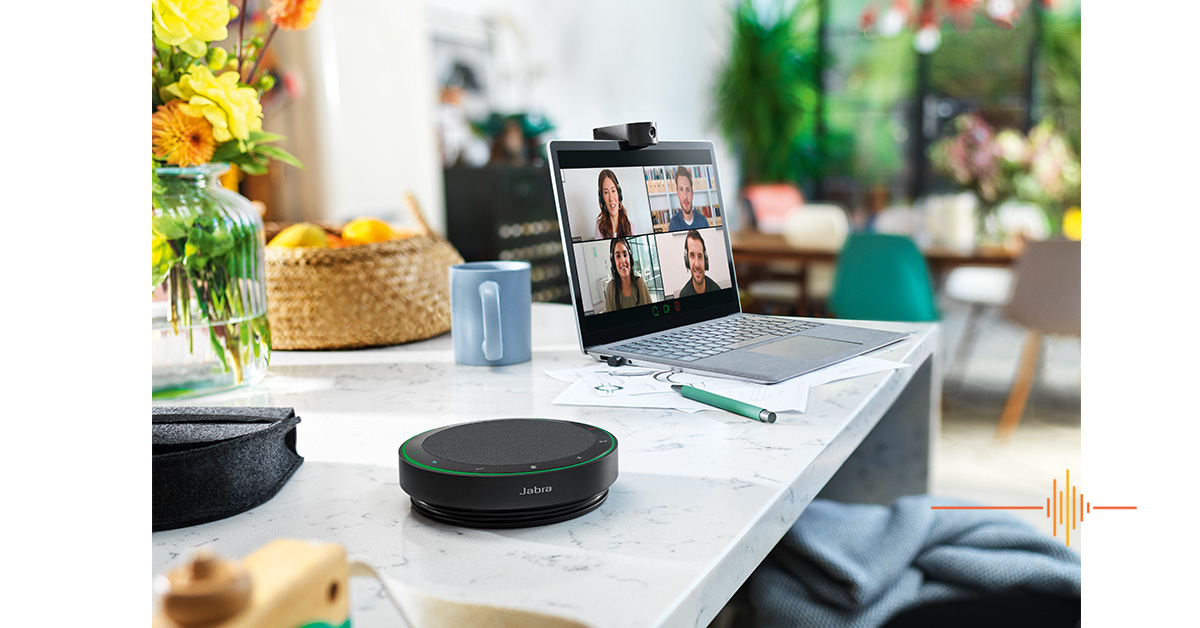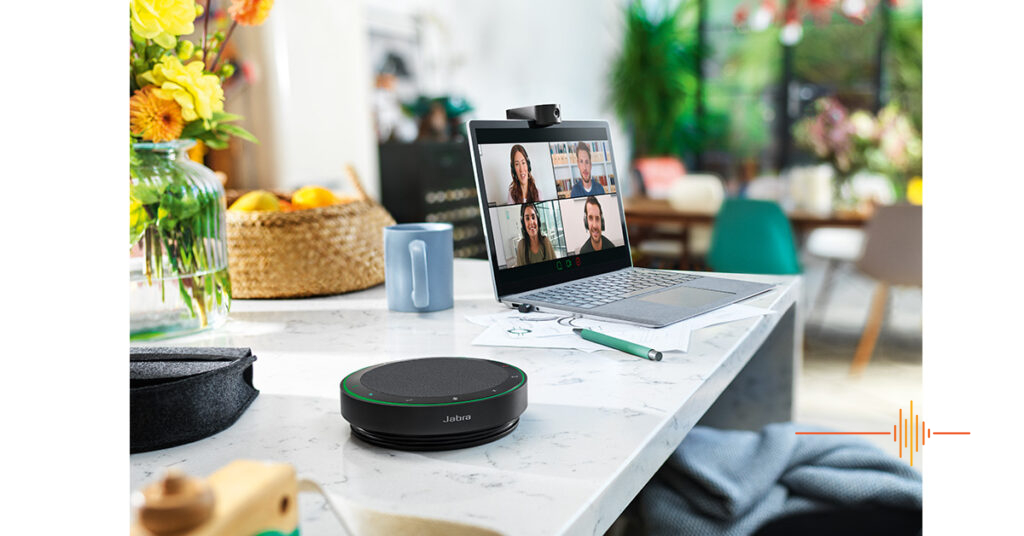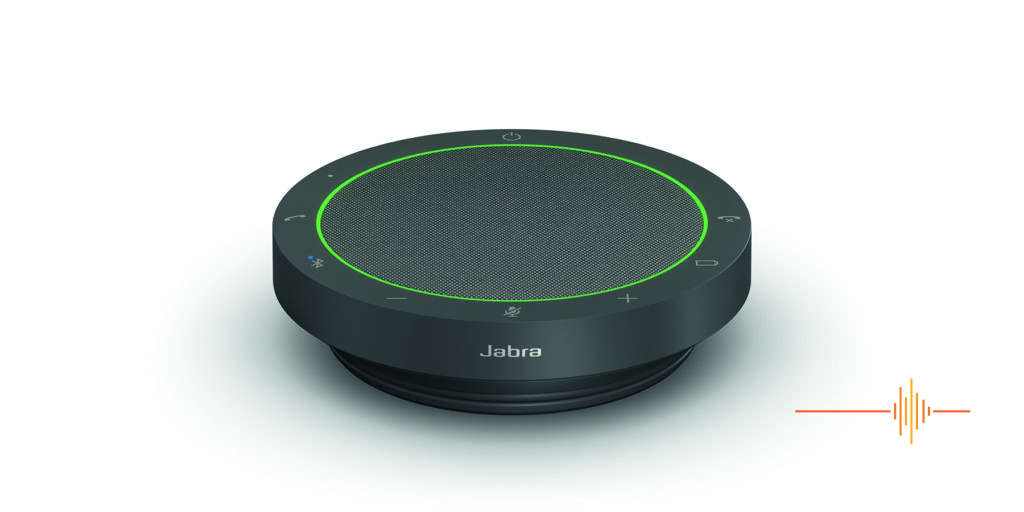Everything has changed since the lockdown, especially teaching. These days I always seem to be finding myself in online meetings with parents, professional development seminars, allied health professionals…even public events with my students. When the editors at DRN told me that Jabra had developed a speakerphone specifically to support large online meetings, I knew the Jabra Speak2 55 is something I had to get my hands on.
First Impressions
The boxing for the Jabra Speak2 55 is artfully simple. A small but sturdy cardboard box sourced from sustainable sources with no soft plastic to be found. The device is safely nestled in a fabric pouch and is completely self contained. There has clearly been a lot of thought put into the environmental impact and design aesthetic of the boxing that I deeply appreciate.
The Speak2 has a single USB-C cable that tucks securely into the base of the device. They have also attached a USB-A adaptor so that it can be connected to any modern device. The buttons that surround the edge are capacitive sensing as opposed to push buttons which adds to the device’s modern, smooth and svelte aesthetic. Perhaps I am a bit old school as I prefer a push button that physically clicks. I found that when I was operating it, the haptic feedback sometimes took a long time to let me know when a button had been successfully pressed.

A calming female voice lets you know the state of the battery and if it has been successfully connected to a device. There is also a ring of light surrounding the speaker in a range of clever ways to communicate battery levels, whether a call has been connected or disconnected and if the device is off or on. It definitely feels like every aspect of this device has been crafted with love and passion.
Set Up
There were a few hiccups in setting up my device. Firstly, I found that the USB-A connection would only partially connect. I was unable to use it to charge the Speak2 and the sound through the speakers was a little warped. The USB-C connection was flawless and charged the device quickly which tells me either that my ancient Department of Education computer may have a damaged USB-A port or that the USB-A adapter on the device was busted.
Once it was effectively charged I was easily able to connect it to my computer by both Bluetooth and using the cable. Initially, it was a little difficult to get my computer to use it as both a microphone and a speaker until I installed the device software – Jabra Direct. Once I had updated the firmware everything ran smoothly and I was able to use it as a microphone and speaker in a range of different contexts. The software didn’t really add much functionality to the device but the firmware update is a must for this device.
In Use
The technical specifications for this device undersell what it is capable of. The speaker was able to smoothly play sounds as low as 20Hz and up to 15,300Hz (probably higher as that might be the limit of my hearing) without any audible cracking or shaking. There was a slight clicking noise that occurred when jumping tracks or adjusting the volume but otherwise it functioned really well as a music speaker. Binaural audio actually sounded pretty good but it wasn’t able to replicate positional audio effects or anything fancy.
The most interesting feature for me was the microphone array. Inside that small device is an array of 4 Digital MEMS type microphones. I tested these in a wide range of school contexts from noisy classrooms, our frenetic front office to the busy playground to see how the ‘ultra-advanced’ software would cope. In every case the device was able to substantially minimise environmental noises while bolstering the sound of human speech. The Speak2 software was able to balance both quiet and loud voices of anyone who was within a table’s worth of distance. Despite all this manipulation, there doesn’t seem to be any noticeable delay in the sound and the voices are crisp, clear and warm. The only drawback of this software is that voices do sound a little echoey. However, anyone who has been on a busy zoom call with a computer mic will know that that is a very small price to pay. Ultimately, I wouldn’t recommend using the microphone function for recording purposes but it is an otherwise exceptional piece of tech.
Gripes
Apart from the lack of push buttons, the USB-A adapter not working for me, the speaker crackling when changing tracks and the mild echo effect on voices, I can’t find anything wrong with this device. Some of these can conceivably be resolved with future firmware updates.
I would probably like to be able to toggle the noise cancellation function on and off to use it to record sound. However, it is a beautiful device that is perfectly fit for the purpose of its design.
Conclusion
If you want a speakerphone to support online meetings on the go, I can’t imagine a device better than this. It comes in a funky little pouch, is completely self contained, technically very sound and comes with powerful software designed to perfectly serve this function. There are so many other great features that I haven’t even mentioned such as its 12 hour battery life, ability to sync with 8 different devices, its portability and modest price (MSRP $269.00 AUD). Ultimately, there are better speakers and better microphones out there for other purposes but for online meetings, this device is a game changer.
DRN would like to thank Jabra for providing the review unit.
Specifications
Ideal for room sizes: Up to 4.5m x 4.5m | 14.76ft x 14.76ft
Number of microphones: 4
Microphone type: Digital MEMS
Microphone frequency range: 150Hz – 7000Hz
Microphone pick up range: Up to 2.3m | 7.55ft
Full Duplex: Yes
Speaker size: 50mm | 1.97in
Peak audio output: 85 dBspl @ 0.5m
Speaker bandwidth (music mode): 100Hz – 20000Hz
Speaker bandwidth (speak mode): 150Hz – 7000Hz
Acoustic echo cancellation (AEC): Yes
Voice Level Normalization (Automatic Gain Control, AGC): Yes (for outgoing audio)
Wideband: Up to 8000 Hz
Noise reduction on calls: Yes
Talk-time: Up to 12 hours
Corded charging: Integrated USB C cable with USB A adapter
Charging time (USB C/A 1 A): Up to 2.5 hours
Charging time (USB C/A 0.5 A): Up to 5 hours
Battery type: Rechargeable lithium-ion battery
Battery capacity: 2 x 900 mA
Connectivity: USB C or USB A, Bluetooth (for smartphone/tablet only)
Bluetooth® version: 5.1
Bluetooth® profiles: A2DP, AVRCP, BLE (for Google Fast Pair), HFP
Operating range (Bluetooth): Up to 30m | 98ft
Paired devices: Up to 8 Bluetooth devices
Simultaneous Bluetooth connections: 2
Integrated USB cable length: ca. 80cm | 31.5in











Unfortunately they cannot be linked anymore for stereo sound… Do for me it’s a nono
Jabra 710 and 750 still the best
Although anker now also has a good alternative